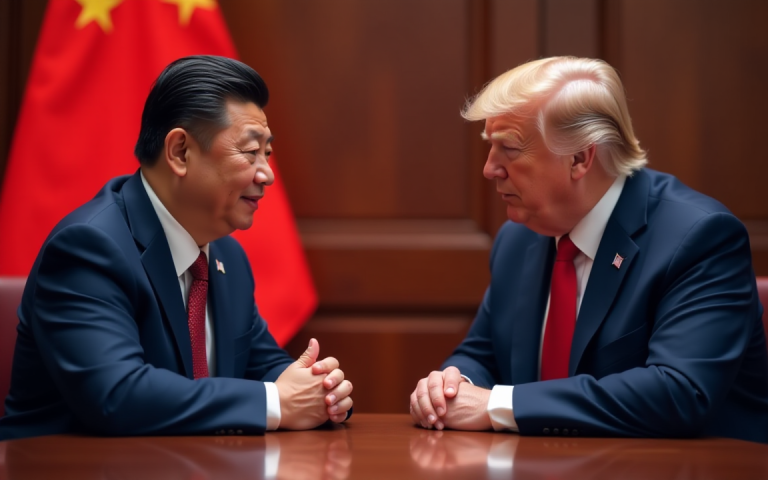The Trump administration on Friday formally closed a trade loophole that had allowed a flood of inexpensive goods from China to enter the United States without tariffs, a move that is likely to benefit domestic manufacturers but hit consumers with higher prices and upend business models of both Chinese exporters and US small firms.
The policy shift, ending the so-called de minimis exemption, caps a years-long controversy over whether China’s low-cost retail platforms—particularly fast-fashion giants like Shein and Temu—were exploiting a regulatory grey area to gain unfair access to American markets.
The rule had permitted shipments under $800 in value to bypass most customs duties and inspections, provided they were sent directly to consumers or small businesses.
Now, those same packages must clear the same tariff barriers and regulatory scrutiny as bulk commercial imports.
What was the ‘De minimis’ rule and why it mattered?
The de minimis exception, introduced in the 1930s, aimed to reduce the burden on customs officials by waiving duties on shipments where collection costs outweighed the revenue.
Congress later raised the threshold to $5 in 1978, $200 in 1993, and $800 in 2016.
For years, the de minimis threshold became a tool of choice for a wide range of exporters and logistics firms.
It enabled sellers in China and elsewhere to send small parcels directly to US consumers without paying duties or providing full documentation.
That created a boom in low-cost cross-border e-commerce, with platforms like Shein and Temu sending tens of millions of parcels annually into American households.
In 2023 alone, US Customs and Border Protection processed over one billion such packages, with the average value of just $54.
But the loophole soon drew bipartisan scrutiny.
Critics, including US manufacturers and labour groups, said the rule gave Chinese sellers an unfair edge and contributed to job losses in warehousing, logistics, and manufacturing sectors.
Others pointed to its alleged use by fentanyl traffickers, who exploited the lax reporting requirements to ship dangerous chemicals into the country.
The administration said drug traffickers were “exploiting” the loophole to ship fentanyl precursor chemicals and related materials into the United States without disclosing shipping details.
“It’s a big scam going on against our country, against really small businesses,” former President Donald Trump said at a White House cabinet meeting this week. “And we’ve ended, we put an end to it.”
Source: BBC
E-commerce retailers hike prices; some exit the US market altogether
Since tariffs on Chinese goods are punishingly high, de minimis goods are already starting to cost a lot more.
Temu has begun promoting goods already located in US warehouses under a new “Local” tag.
Shein has reassured shoppers that while some prices may change, the bulk of its offerings remain affordable.
Shoppers, however, say they saw prices for some items on Shein’s website rise over the weekend, according to a NYT article.
Both platforms have also recently cut back digital advertising in anticipation of the rule change affecting sales.
British clothing brand Oh Polly has also increased its US prices by 20%.
The American Action Forum estimated the change could impose $8 billion to $30 billion in new annual costs—ultimately borne by consumers.
Other firms, such as Understance (a Canadian underwear company), say they will halt shipments to the US altogether.
Beauty retailer Space NK has also paused US online orders, citing concerns over compliance and costs.
“I’ve seen a lot of small to medium-sized businesses just choose to exit the market altogether,” said Cindy Allen, CEO of Trade Force Multiplier, a global trade consultancy.
Who wins?
Industry groups in the US have welcomed the change.
Kim Glas, president of the National Council of Textile Organizations, said the exemption had “devastated the US textile industry” by allowing duty-free entry of unsafe and illegal goods, with textile and apparel items making up more than half of all de minimis shipments by value.
“This tariff loophole has granted China almost unilateral, privileged access to the US market at the expense of American manufacturers and US jobs,” Glas said in comments to the New York Times.
The impact has been visible across niche sectors too.
The Flag Manufacturers Association of America, in written comments to the US Trade Representative, said its members have faced an influx of deeply discounted American flags imported from China—often falsely labelled—which has led to a 25% to 35% decline in domestic flag sales last year.
Larry Severini, CEO of Embroidery Solutions Manufacturing LLC, which supplies embroidered star fields to US flag makers, said he was forced to close one of his two plants in South Carolina earlier this year due to pressure from low-cost imports.
Sales have fallen by about 20% since 2021, which he partly attributes to the de minimis provision.
“We need duties to level the playing field to make it fair,” Severini said.
The end of the de minimis exemption for Chinese goods could also offer an advantage to retailers less reliant on online platforms or Chinese manufacturing.
British fast-fashion retailer Primark, which serves US customers solely through its brick-and-mortar stores, sees an opportunity in the policy shift.
“With prices going up from this part of the trade, I wonder if some Americans might start going back to shopping centres to find value there,” said George Weston, CEO of Primark’s parent company, Associated British Foods, in an interview with Reuters on Tuesday.
Impact on logistics
The change is expected to impact airlines and private carriers such as FedEx and UPS, which have long relied on steady business transporting low-value goods to the United States.
UPS, FedEx, DHL, and the US Postal Service say they are ready to implement the changes.
Yet the economic model that underpinned fast e-commerce deliveries from overseas warehouses may soon be upended.
Logistics experts believe sellers with strong profit margins will continue shipping from China, while others may invest in US-based warehousing to manage costs.
“There’s going to be price hikes, but China’s manufacturing base is still too strong to abandon,” said Izzy Rosenzweig, CEO of logistics firm Portless.
“That said, a lot of razor-thin-margin sellers will likely go local.”
Experts debate likely impact on drug trade and strain on customs personnel
One of the administration’s justifications for ending de minimis was its alleged role in enabling the smuggling of fentanyl and its precursor chemicals.
However, experts caution the policy’s effectiveness in stemming drug flows may be limited.
Many synthetic opioids still enter through the southern border with Mexico, not through international air freight.
Besides, pro-trade groups like the National Foreign Trade Council argue that removing de minimis could stretch already thin customs resources.
“CBP would need to hire and train new personnel, costing the agency millions or causing them to move agents from the already overburdened southern border,” the group warned.
US Customs and Border Protection, however, says it is prepared.
“We are equipped to carry out enhanced package screenings and enforce orders effectively,” a spokesperson said.
The economic stakes for China
The decision comes at a delicate time for China’s export-driven economy.
The end of de minimis treatment for its e-commerce shipments is expected to hurt companies like Shein, Temu (owned by PDD Holdings), and others that have built thriving US operations under the now-defunct rule.
Bob Chen, a director at Shenzhen-based venture firm Mangrove Capital, said the policy shift would “have a large impact on China’s low-cost goods-selling platforms.”
Sellers may be forced to either absorb the tariff costs or pass them on to consumers, jeopardising their price competitiveness.
Yet Chen also noted that even after price adjustments, Chinese platforms may remain attractive due to their efficient supply chains and economies of scale.
“They are still competitive on price,” he said. “And I don’t think other platforms such as Amazon [could replace them].”
In 2023, China’s cross-border e-commerce exports surged to $93.6 billion, a 42% year-on-year jump, making it the country’s second-largest export category.
A significant portion of that was destined for US consumers.
The post De minimis gone: how a little rule change is likely to upend US-China e-commerce flows appeared first on Invezz










